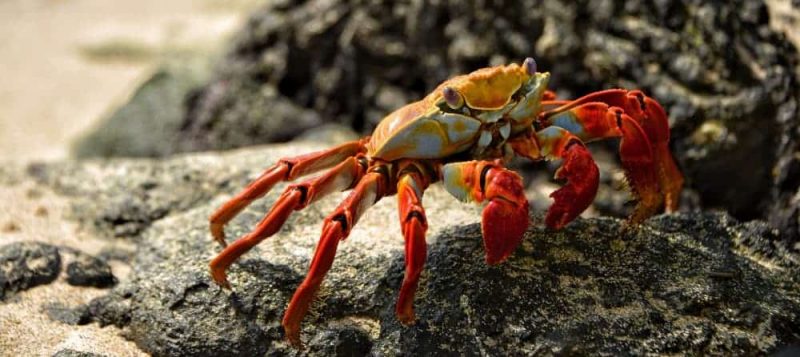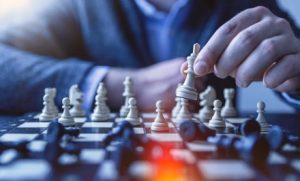What is Astaxanthin?
Have you ever wondered where salmon gets its red color from, why lobsters turn red when cooking or why flamingos have such an exotic color?
The answer to this question is astaxanthin – a super-carotenoid antioxidant found naturally in yeasts, mushrooms, salmon and trout, lobsters and crabs, shrimp, krill and sea urchins, and algae (Haematococcus pluvialis aka blood rain algae, but also the feathers of individual bird species.

Other representatives of the group of carotenoids include Fucoxanthin, zeaxanthin, lutein or the pro-vitamin beta carotene, which forms a precursor of vitamin A and has a similar chemical structure, such as astaxanthin.
Carotenoids continue to divide into carotenes (e.g., vitamin A precursors) or xanthophylls. Astaxanthin belongs to the xanthophyllene.
Xanthophylls can not be converted into vitamin A (retinol) under normal circumstances, which is why they are generally considered safer than vitamin A precursors (since there is no risk of hypervitaminosis).
Astaxanthin is also considered safe by the US Food and Drug Administration (FDA) according to GRAS standards.
Astaxanthin can be found in everyday foods (such as fish), added to products as a dye, or in the form of nutritional supplements.
In aquaculture, it is often used as a feed additive, so that the fish meat takes on a distinctive reddish color.
There is a similar story about egg production, which aims to give the yolks of the eggs a healthy yellow color. It uses either natural astaxanthin (less likely) or a synthetically-made form (more likely).
Why do marine animals (such as lobsters, crabs) actually turn red when cooked?
The answer: Astaxanthin is normally bound to proteins. The protein denatures during cooking and astaxanthin is released. The pigments absorb the light and the lobster gets its characteristic red color.
Astaxanthin – What’s its Effect and Benefits?
Astaxanthin is used as:
- Sun protection factor (popular supplement for Ironman athletes)
- Antioxidant in order to strengthen the immune system (strongest known to mankind antioxidant)
- Protection against neurodegeneration (for brain and eye health)
- Strengthen cardiovascular health
- Improvement of regeneration & reduction of muscle damage (as a result of training)
- Cure against joint and muscle pain
- Testosterone booster
- Tool to slower skin aging (astaxanthin-containing cream)
- Benefits longevity
Astaxanthin has a whole truckload of benefits and areas for which it is used – including the sports sector where to increase performance and regeneration.
One of Astaxanthin’s greatest benefits is, that it is one of the strongest, if not the strongest, antioxidant known to man. Astaxanthin never acts pro-oxidatively and is able to cross both the blood-brain barrier and retinal barriers so that it can exert a protective effect on the brain and eyes.
Do you want to know how strong astaxanthin is as an antioxidant?
6000 times stronger than vitamin C
800 times stronger than coenzyme Q10
550 times stronger than green tea catechins and vitamin E
Not bad, right?
Astaxanthin has an anti-inflammatory effect and is regarded as a low-side-effect alternative to nonsteroidal anti-inflammatory drugs (aspirin, ibuprofen, etc.), as it is naturally derived and acts on several signaling pathways.
“When one considers current anti-inflammatory products on the market, most have serious side effects. Aspirin has anti-inflammatory effects, but prolonged use can cause stomach bleeding and ulcers. Nonsteroidal anti-inflammatory drugs (NSAIDs) such as acetaminophen (Tylenol?) can cause liver damage. Prescription anti-inflammatory drugs such as Vioxx? and Celebrex? can cause heart problems. After many years of use and extensive safety studies, natural astaxanthin has never been documented as having any side effects or contraindications. It is a safe alternative to the high-risk category anti-inflammatories.”
Capelli, B. / Jenkins, U. / Cysewski, GR. (2013)

Astaxanthin Benefits for Athletes
It is no longer a secret that intense physical stress, such as exercising, leads to high levels of oxidative stress.
The usage of antioxidants is regarded as effective to support the body’s own defense systems and to improve regeneration.
In addition to vitamins E and C, coenzyme Q10, beta carotene and isoflavonoids, astaxanthin, as the strongest natural antioxidant, is likely to have an important upside in the performance-oriented athletes.
If you look at the animal kingdom, you’ll find that salmon has the strongest concentration of astaxanthin available in its muscle tissues.
However, salmon can not synthesize astaxanthin on their own – they absorb astaxanthin through microalgae due to its diet.
Researchers are now speculating about the role of astaxanthin in the sheer immense endurance capacity of salmon, which floats upstream for a few weeks – against the tide – to reach its spawning grounds.
It is believed that the muscle-enriched astaxanthin causes free radicals to be eliminated faster and more efficiently. In addition, this interesting substance could also have a performance-enhancing effect for humans.
Thus, this is exactly what we will look at in the final chapter of the guide: The effects of Astaxanthin for Athletes.
Does the Antioxidant Astaxanthin Increase Athletic Performance?
In fact, as a “supplement” in sport, Astaxanthin could improve performance and muscle function.
In a study, animals given 100mg of natural astaxanthin (0.2mg / kg) over a period of 2 weeks cured rhabdomyolysis and remained healthy as long as they continued to receive astaxanthin.
However, there is also a human study in which 40 college students in a placebo-controlled double-blind trial received either one placebo or 4 mg astaxanthin per day.
The strength and endurance were determined by the number of squats (40kg) that the subject had to perform under standardized conditions.
Strength and endurance increased by an average of 61.74% in the astaxanthin group.
In comparison, the placebo group only “improved” by 23.78%.
Basically, this means that the participants who receive the astaxanthin gain about 3 times faster in strength and endurance than their counterparts who received the placebo.
Finally, in 2002, the first published study was carried out to investigate the effects of oral astaxanthin supplementation on human muscle function.
Here, the researchers involved showed that supplementation with astaxanthin showed a trend towards lower CK levels and lowered serum lactate levels by up to 28.6% on average.
The results of this human study are supported by an animal experiment which was carried out a short time later. Here, mice had to run on a treadmill until exhaustion. In the end, it was found that the mice receiving natural astaxanthin had lower oxidative damage to heart and calf muscles than the control group that had to run without astaxanthin.
This animal study is so interesting and important because it shows that Astaxanthin, unlike other carotenoids, is not only concentrated in the liver but also accumulates in other tissues (heart and skeletal muscles).
This makes astaxanthin unique.
In a second human series of experiments, also a Japanese study, the effect of astaxanthin use on exercise-related body changes was investigated.
The exercise test included running on the treadmill at different exercise intensities (30%, 50% and 70% of the maximum heart rate), and also performed breath analyzes and blood samples.
At the end of the study it was found that the administration of astaxanthin modulates the activity of the sympathetic and parasympathetic nervous system – or more concretely:
Astaxanthin reduces the activity of the sympathetic nervous system and increases that of the parasympathetic nervous system.
At the same time, astaxanthin reduced cholesterol and respiratory quotient after exercise (implying improved fat metabolism and fat burning).
Does Astaxanthin Benefit Athletic Performance?
Let’s first look at an animal experiment from 2006, in which the researchers involved wanted to investigate the effects of an astaxanthin supplement on swimming performance.
Following the participants had to swim to exhaustion. The result?
The astaxanthin mice swam significantly longer than their counterparts, who received a normal, non-astaxanthin-enriched diet.
This finding suggests that astaxanthin benefits endurance.
The researchers found that lactate levels were lower in the mice receiving astaxanthin than in control mice.
Side effect: Taking astaxanthin resulted in lower fat accumulation in the animals that received it (they gained less fat compared to the control rodents).
What a great side effect, right?
Aoi and colleagues (2008) were also able to verify the positive effect on lipid metabolism in mice whose diets were supplemented with astaxanthin for 4 weeks.
The astaxanthin-related key benefits of this study were:
- a better use of fat
- longer duration until exhaustion
- less fat mass
- improved metabolism in the muscles
Does the Antioxidant Astaxanthin Benefit Endurance?
In 2008, a paper by Malmsten / Lignell was published, the aim of which was to work out the effect of astaxanthin on strength endurance.
The researchers recruited 40 healthy male college students aged 17-19 years. This 6-month experiment was a placebo-controlled double-blind trial in which the astaxanthin group had to take 4 mg each day.
For this purpose, the participants had to complete as many 90-degree squats as possible, again at the multi-press, under standardized conditions and sub-maximum load.
The result: Both groups showed improvements in strength and endurance, but the differences between the groups were obvious.
The placebo group increased their average number of squats by 9, while the astaxanthin group an average of 27 more than at the beginning.
In other words, the college students who received the astaxanthin increased their performance by 62% (with a daily intake of 4 mg astaxanthin), while the participants in the placebo group averaged their performance “only” could improve by 22%.
The increase in performance can not be explained by improved fitness or lactate tolerance, according to the authors.
The antioxidant Astaxanthin is, therefore, able to benefit mitochondrial functions.
Another study on cyclists showed that Astaxanthin can improve the power output by 15% In just 5 weeks.
Of course, at this point – in order to complete the picture – I should not leave out the studies in which no performance-enhancing effects could be demonstrated.
For example, Res and colleagues (2012) found no difference in fat metabolism and performance in 32 well-trained cyclists as a result of a 4-week, parallel-design, placebo-controlled, double-blind study with a daily dose of 20 mg astaxanthin.
That 20 mg dosage is damn high – so high that it’s nearly too much of the good stuff.
Especially since we know today that too many antioxidants are just as bad as too little.
Astaxanthin Dosage for Best Benefits and Longevity
Since astaxanthin is a fat-soluble antioxidant from the carotenoid group, it is important to take it with some fat.
Some Astaxanthin products come in a convenient and easy-to-consume oil capsule.
However, avoid taking astaxanthin around the workout.
Adaptation studies imply that the exogenous delivery of antioxidants around the workout may significantly disrupt adaptive processes within the musculature.
As a result, Astaxanthin intake right before and after workouts probably affect muscle growth and long-term progression negatively.
Remember, a certain degree of inflammation is beneficial when building muscle and strength.
There are different dosage recommendations for taking Astaxanthin – depending on which goal you have.
Dosage recommendations range from 4mg – 12mg.
As there are no reference levels for the dosage of astaxanthin (and upper limits are not fixed), you should stick to the respective recommended intake on the packaging.
A 4-week “loading phase” with 12 mg astaxanthin and a transition to a maintenance dose of 4 mg per day would be conceivable if general health is in the foreground, whereby even quantities of 4 mg astaxanthin per day have had a positive effect.
Alternatively, you can also stay with 4mg in the long term.

Astaxanthin – Side Effects
The long-term intake of up to 6mg astaxanthin per day does not seem to have any adverse effects on individual blood parameters in humans.
In vitro studies imply a wide therapeutic range (meaning: the higher the therapeutic range, the safer the substance).
However, there are no studies investigating the long-term use of more than 6 mg of astaxanthin per day.
Park and colleagues (2010) showed that taking 8 mg astaxanthin for 8 weeks lowers oxidative stress and inflammatory responses. In addition, the intake positively affects the immune response in humans without developing negative side effects.
Acute ingestion of high levels and long-term use of more than 20 mg astaxanthin per day may result in a red coloration of the stool, which is completely harmless but can be confused with intestinal bleeding.
Conclusion: Astaxanthin Benefits
Astaxanthin is definitely worth a try for any athlete because it appears to possess some major benefits.
Most important, make sure you don’t take it right before the workout and stay within a reasonable range.
Personally, I recommend using 6mg daily.
In conclusion, these are the Astaxanthin benefits in short:
- Acts as an antioxidant to strengthen the immune system
- Protection against neurodegeneration (for the brain)
- Strengthen cardiovascular health
- Improvement of regeneration & reduction of muscle damage (as a result of training)
- Works against joint and muscle pain
- Testosterone booster
- Improves performance (endurance + strength training)
- Against skin aging (astaxanthin-containing cream)
- Increases longevity
Now, I hope this guide was helpful and instructive, but above all useful for your own practical implementation.
Have you ever used Astaxanthin yourself? What are your opinions about Astaxanthin as a supplement?
Let me know about your thoughts in the comments below!
Cheers,
Sam





4 thoughts on “Astaxanthin Benefits for Athletes (9 Crucial Benefits)”
Hi there! Such a wonderful write-up, thank you!
Thanks!
I sort of fell backwards into my own accidental double-blind test of astaxanthin.
I had been concerned that my summer outdoor activities, even with sunscreen, was affecting my skin, harming it. Even though I didn’t have any meaningful wrinkles, I did see some discolouration from sun exposure.
So I started taking astaxanthin as a skin/tissue protocol. It was 4 or 8mg/day.
Some time after starting this, I started blowing through my workouts. At first I didn’t really notice, except when logging results – weights, speed, reps etc – which started to climb… fast. While I’m not old by any stretch, I’m at a fitness level and age where improving this quickly is very unusual, considering I changed nothing in my routine, other than striving for new personal bests whenever I could get them. But blowing them away by 20 and 30% was out of the blue and defies logic.
After tracing back my timeline I then realized that astaxanthin was the only new variable in my life preceding this jump. Which then led me to investigate athletic benefits of astaxanthin; and then learned about its stamina-building properties.
So it’s real alright, thanks to my accidental double blind test, and I can’t believe it’s not more of a household name, still.
Hi Cornelius! Thank you very much for sharing your own experiences with our community – this story definitely backs up the evident benefits of Astaxanthin intake. Cheers, Janik